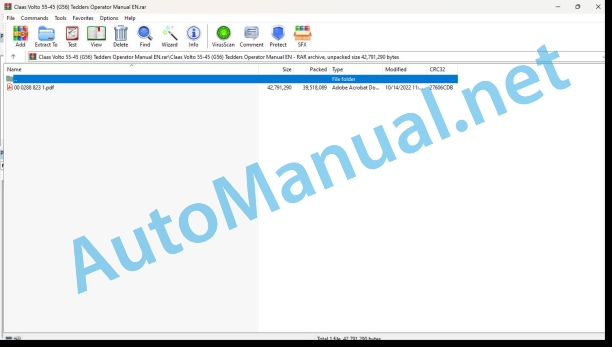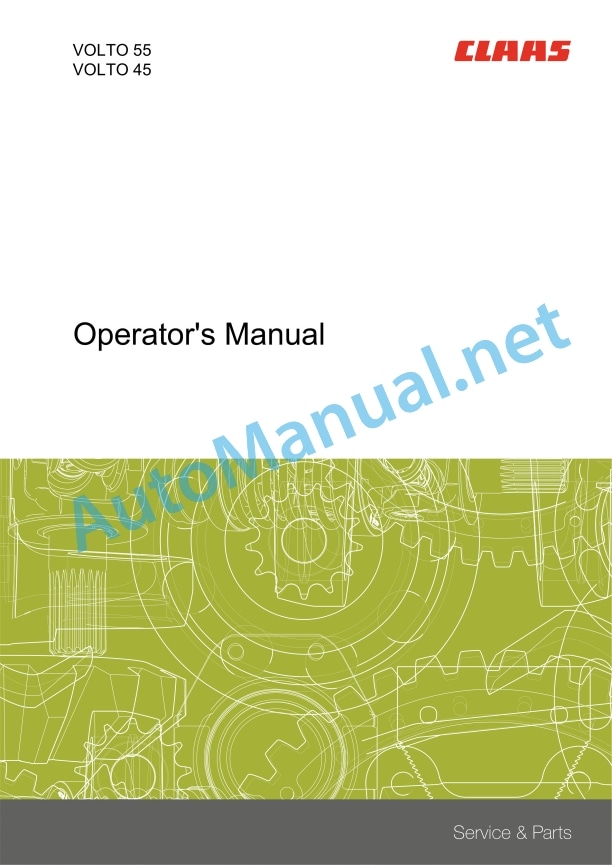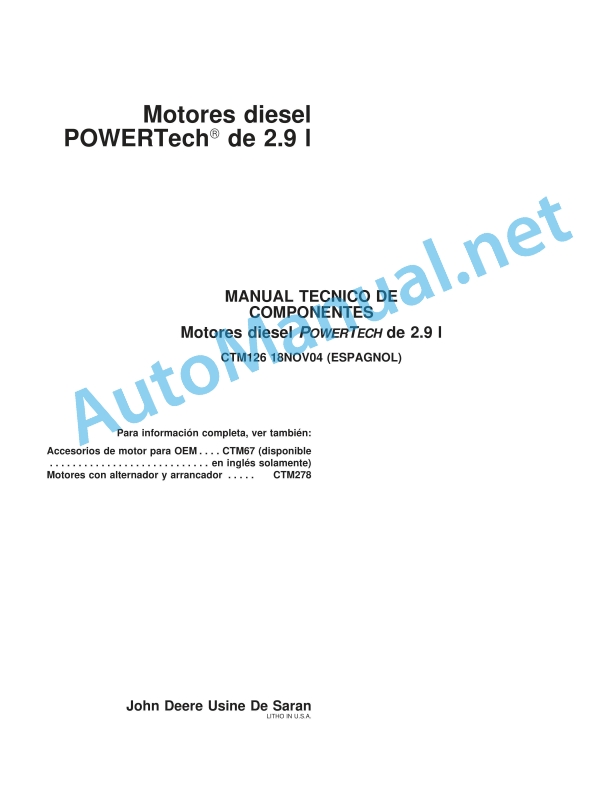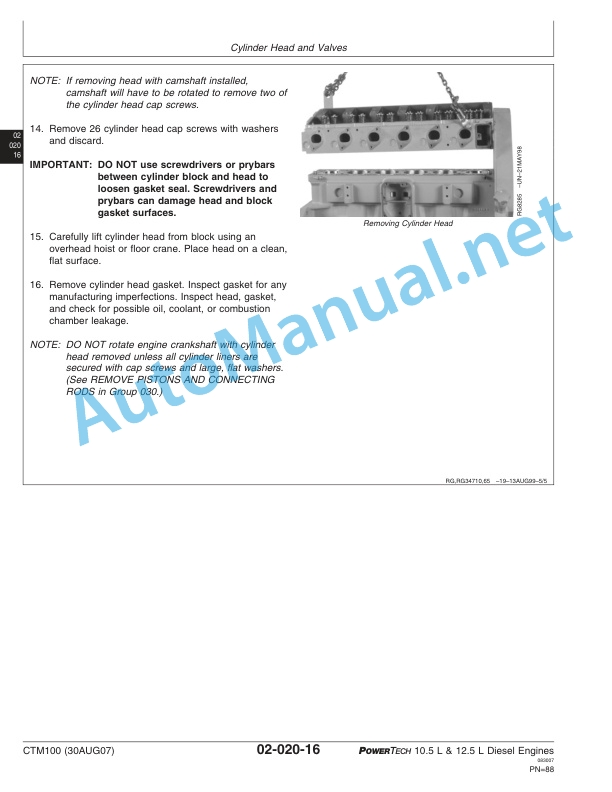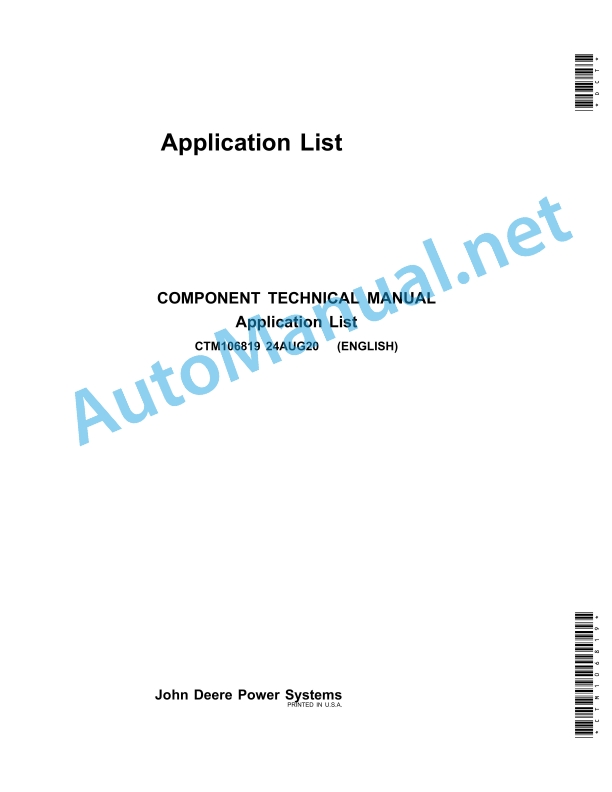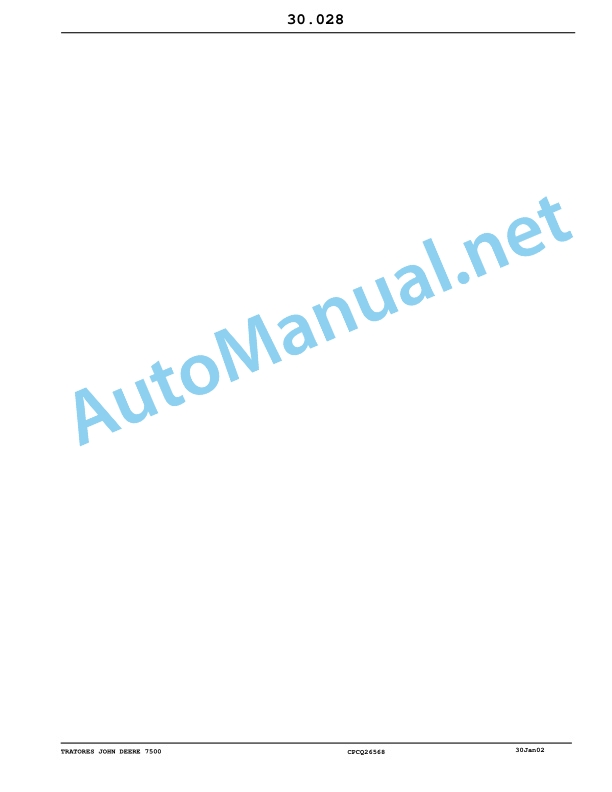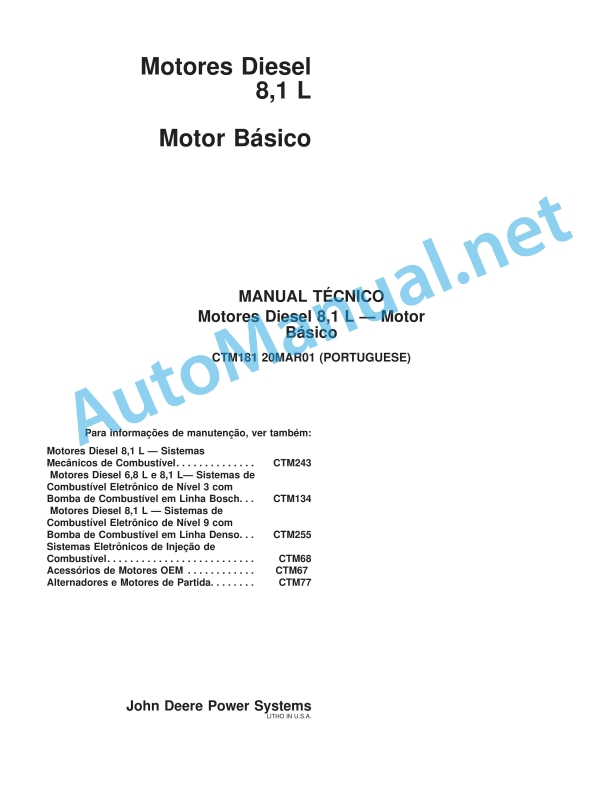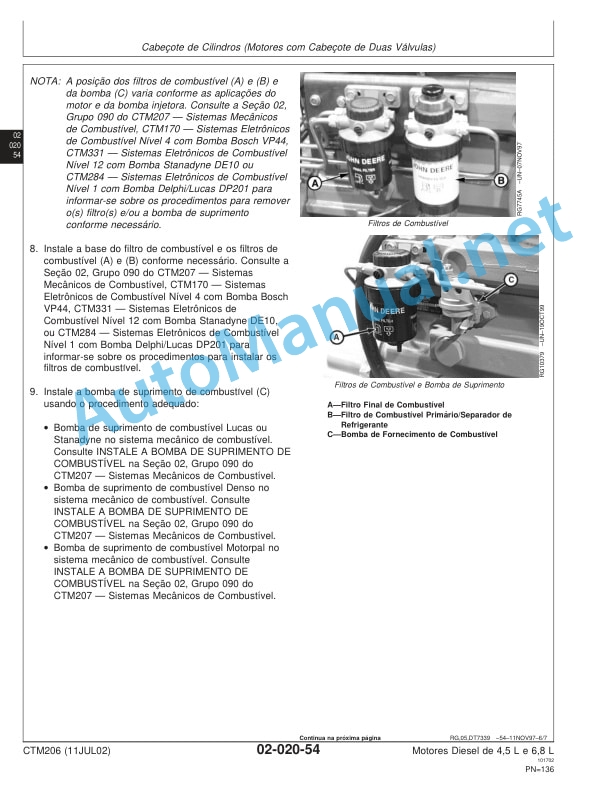Claas Volto 55-45 (G56) Tedders Operator Manual EN
$50.00
- Model: Volto 55-45 (G56) Tedders
- Type Of Manual: Operator Manual
- Language: EN
- Format: PDF(s)
- Size: 37.7 MB
File List:
00 0288 823 1.pdf
00 0288 823 1.pdf:
VOLTO 55VOLTO 45
Table of contents
1 Introduction
1.1 General information
1.1.1 Validity of the manual
1.1.2 Information about this Operator’s Manual
1.1.3 Symbols and notes
1.1.4 Optional equipment
1.1.5 Qualified specialist workshop
1.1.6 Maintenance notes
1.1.7 Warranty notes
1.1.8 Spare parts and technical questions
1.2 Intended use
1.2.1 Intended use
1.2.2 Reasonably foreseeable misuse
2 Safety
2.1 Identifying warnings
2.1.1 Hazard signs
2.1.2 Signal word
2.2 Safety rules
2.2.1 Importance of Operator’s Manual
2.2.2 Observing safety decals and warnings
2.2.3 Requirements for all persons working with the machine
2.2.4 Children in danger
2.2.5 Hazard areas
2.2.6 Staying between the tractor and the machine
2.2.7 Persons riding on the machine
2.2.8 Hitching the tractor to the machine
2.2.9 Risk of injury from rotating shafts
2.2.10 Structural changes
2.2.11 Optional equipment and spare parts
2.2.12 Control of the machine while it is running
2.2.13 Operation only after proper putting into operation
2.2.14 Technical condition
2.2.15 Danger resulting from damage to the machine
2.2.16 Complying with technical limit values
2.2.17 Danger from machine parts running on
2.2.18 Keeping the safety devices functional
2.2.19 Personal protective equipment
2.2.20 Wearing suitable clothing
2.2.21 Removing dirt and loose objects
2.2.22 Preparing the machine for road travel
2.2.23 Hazards when driving on the road and in the field
2.2.24 Parking the machine safely
2.2.25 Unsupervised parking
2.2.26 Unsuitable operating materials
2.2.27 Safe handling of operating materials and auxiliary materials
2.2.28 Environmental protection and disposal
2.2.29 Fire prevention
2.2.30 Pressurised fluids
2.2.31 Only carry out work on the machine when it is stopped
2.2.32 Maintenance work and repairs
2.2.33 Raised machine parts and loads
2.2.34 Danger from welding work
2.3 Safety decals on the machine
2.3.1 Layout of safety decals
2.3.2 Safety decals on the machine
3 Machine description
3.1 Overview and method of operation
3.1.1 Machine overview
3.1.2 Function of machine
3.2 Optional equipment
3.2.1 Slip yoke kit*
3.2.2 Tine loss protection ø 9.5 mm*
3.2.3 Mechanical swathing curtain*
3.2.4 Hydraulic swathing curtain*
3.2.5 Castor guide wheel*
3.2.6 Spare wheel, 16×6.5-8*
3.2.7 Night swathing gearbox*
3.2.8 Warning plates*
3.2.9 Warning plates with lighting*
3.2.10 Warning plates for Italy*
3.2.11 Legal equipment for France*
3.3 Identification plates and vehicle identification number
3.3.1 Machine identification plate
3.4 Information on the machine
3.4.1 Stickers on the machine
4 Operating and display elements
4.1 Controls
4.1.1 Transport safety equipment pull rope
5 Technical speciiations
5.1 VOLTO 55
5.1.1 Dimensions
5.1.2 Weights
5.1.3 Requirements for the tractor
5.1.4 Version
5.1.5 Tyre size
5.1.6 Tyre pressure
5.1.7 Sound pressure level
5.1.8 Lubricants
5.2 VOLTO 45
5.2.1 Dimensions
5.2.2 Weights
5.2.3 Requirements for the tractor
5.2.4 Version
5.2.5 Tyre size
5.2.6 Tyre pressure
5.2.7 Sound pressure level
5.2.8 Lubricants
6 Machine preparation
6.1 Switching off and securing the machine
6.1.1 Switching off and securing the tractor and machine
6.1.2 Securing the raised machine
6.2 Tractor preparation
6.2.1 Checking the ballasting of the tractor
Calculating the minimum front ballast
Calculating the minimum rear ballast
Calculating the actual front axle load
Calculating the actual total weight
Calculating the actual rear axle load
Calculation table
6.2.2 Checking the protective guard on the tractor PTO shaft
6.3 Adapting the machine
6.3.1 Universal drive shaft – checking the length
6.3.2 Adapting the universal drive shaft length
6.3.3 Fitting the universal drive shaft to the machine
6.4 Hitching the machine
6.4.1 Hitching the 3-point hitch
6.4.2 Installing the universal drive shaft
6.4.3 Plugging in the lighting cable*
6.4.4 Connecting the hydraulic hose
6.4.5 Connecting the hydraulic hose line for the swathing curtain*
6.4.6 Raising the stands
6.4.7 Stowing the wheel chocks
6.5 Unhitching the machine
6.5.1 Extending the stand
6.5.2 Positioning the wheel chock at the wheel
6.5.3 Unplugging the lighting cable*
6.5.4 Disconnecting the hydraulic hoses
6.5.5 Disconnecting the hydraulic hose for the hydraulic swathing curtain*
6.5.6 Removing the universal drive shaft
6.5.7 Unhitching the 3-point hitch
6.6 Prepare road travel
6.6.1 Folding the machine into the transport position
6.6.2 Performing checks prior to road travel
6.7 Preparing fieldwork
6.7.1 Folding the machine to the working position
6.7.2 Adjusting the spreading angle
6.7.3 Adjusting the tines
6.7.4 Adjusting the swathing curtain*
6.7.5 Adjusting the working height with the castor guide wheel*
6.8 Loading the machine
6.8.1 Lifting the machine
7 Operation
7.1 Driving on the road
7.1.1 Driving on public roads
7.2 Fieldwork settings
7.2.1 Adjusting the spreading pattern
7.2.2 Setting the working height
7.2.3 Repositioning the universal drive shaft
7.3 Fieldwork
7.3.1 Folding the machine into the transport position
7.3.2 Folding the machine to the working position
7.3.3 Machine use
7.3.4 Tedding
7.3.5 Tedding
7.3.6 Swath spreading
7.3.7 Night swaths
7.3.8 Swath tedding
7.3.9 Folding out the swathing curtain*
7.3.10 Folding in the swathing curtain*
7.3.11 Tedding with the swathing curtain*
8 Faults and remedies
8.1 Overview of problems
8.1.1 Overview of problems on the machine
8.2 Chassis
8.2.1 Changing the wheel on the rotor running gear
8.2.2 Changing the castor guide wheel*
8.3 Electric and electronic system
8.3.1 Defective incandescent lamps*
9 Maintenance
9.1 Maintenance interval overview
9.1.1 Before the harvest
9.1.2 After the first 10 operating hours
9.1.3 After the first 50 operating hours
9.1.4 Every 8 operating hours or daily
9.1.5 Every 50 operating hours
9.1.6 Every 500 operating hours or annually
9.1.7 Every 5 years
9.1.8 After the harvest
9.2 Gearbox
9.2.1 Checking the gearbox for leaks
9.2.2 Changing the lubricant in the main gearbox
9.2.3 Changing the lubricant of the rotor gearboxes
9.2.4 Check the night swathing gearbox* oil level
9.2.5 Changing the night swathing gearbox* oil
9.3 Clutches
9.3.1 Checking the overload clutch
9.4 Universal drive shaft
9.4.1 Servicing the universal drive shafts
9.5 Chassis
9.5.1 Check the tyre pressure
9.5.2 Checking the wheel nuts on the rotor running gear
9.5.3 Check the castor guide wheel* nut
9.6 Drives
9.6.1 Greasing the PERMALINK finger clutches
9.7 Hydraulic system
9.7.1 Checking the hydraulic hoses
9.7.2 Checking the accumulator*
9.8 Tine carrier
9.8.1 Checking the tines
9.9 Assembled parts/Machine housing
9.9.1 Clean the machine
9.9.2 Preserve the machine
9.9.3 Check the fittings
9.10 Lubrication plan
9.10.1 Greasing points to be greased every 8 operating hours
9.10.2 Lubricate lubrication points every 50 operating hours
10 Putting out of operation and disposal
10.1 General information
10.1.1 Putting out of operation and disposal
11 EC declaration of conformity
11.1 VOLTO 55 / 45
11.1.1 EC Declaration of Conformity
12 Technical terms and abbreviations
12.1 Terms and explanations
12.1.1 Technical words
12.1.2 Abbreviations
John Deere Repair Technical Manual PDF
John Deere Diesel Engines POWERTECH 2.9 L Component Technical Manual CTM126 Spanish
John Deere Repair Technical Manual PDF
John Deere Repair Technical Manual PDF
John Deere Diesel Engines PowerTech 4.5L and 6.8L – Motor Base Technical Manual 07MAY08 Portuguese
John Deere Repair Technical Manual PDF
John Deere 16, 18, 20 and 24HP Onan Engines Component Technical Manual CTM2 (19APR90)
John Deere Repair Technical Manual PDF
John Deere Application List Component Technical Manual CTM106819 24AUG20
John Deere Parts Catalog PDF
John Deere Tractors 7500 Parts Catalog CPCQ26568 30 Jan 02 Portuguese
John Deere Repair Technical Manual PDF
John Deere Repair Technical Manual PDF
John Deere Repair Technical Manual PDF
John Deere Repair Technical Manual PDF

